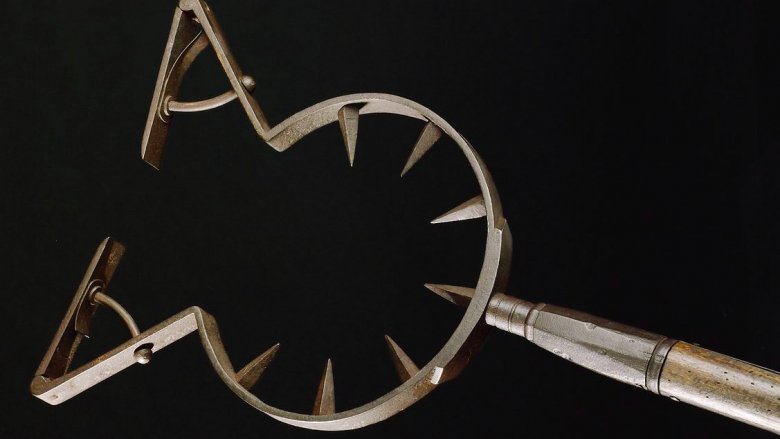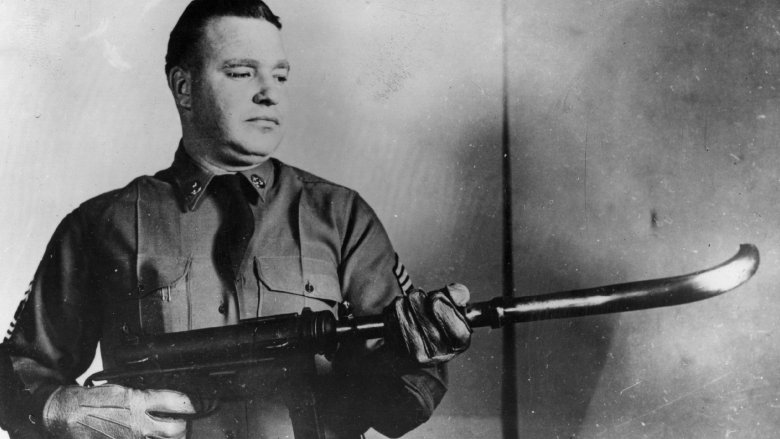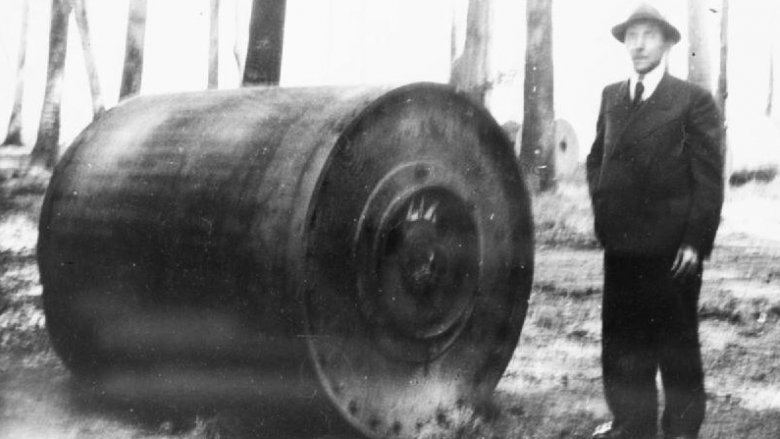
Human ingenuity has given us all sorts of marvelous inventions, from the airplane to indoor plumbing to the chocolate chip cookie. But nowhere has human ingenuity soared quite so much as in the quest to produce objects that will kill, maim, and destroy, preferably in the most disgusting and horrible way ever. Yes, death is the great equalizer, but weapons are the things that make some people equal, and put others on top of thrones.
Some weapons, like the sword and the crossbow, have been around for generations, and will still be in use long after most of the human race has been devoured by zombies. Other weapons were a lot less practical, but they certainly were creative, though sometimes they were more funny than lethal. Those weapons may not kill zombies any time soon, but they certainly deserve a place in the history books as crowning achievements in weird weaponry.
Thanks for the light, man

According to Hollywood, the Renaissance was a time of shiny knights, colorful ladies, and people playing lutes all the time. The non-Hollywood truth, though, is that the Renaissance sucked. If you were a peasant, you lived in a house made out of mud and cow crap and you slept in the same room as your farm animals. The upside was that no one would ever rob you if you were walking around in the streets alone at night, because everyone knew you had nothing to steal.
If you weren’t a peasant, though, you did have to worry about walking around the streets alone at night, so you needed a lantern shield … said only the guy who invented the lantern shield.
According to All Things Medieval, this weapon was about a foot in diameter and was covered with scary, pointy things. It also had a lantern hidden by a flap of leather. When you moved the flap, the light from the lantern was supposed to blind your opponent, so he’d either run away or make a fatal mistake. Never mind the part where it was just a lantern, not like a floodlight or something, so the light reveal was probably not “my eyes, I’m blind” but more like “thanks, now I can see your coin purse that I was trying to steal.” The thing supposedly did look pretty gnarly, though, so it may have been a decent deterrent.
You probably would not want to try running from this thing

The “man catcher” looks like something out of a Mad Max movie, but it was actually a real thing, and that’s actually what it was for, literally, “man catching.” It was used in Europe during the Middle Ages, and according to Syed Ramsey’s Tools of War: History of Weapons in Medieval Times, all the way into the 18th century.
The man catcher was basically a spiked collar on the end of a pole that you could use to grab someone by the neck and pull him off his horse. The idea was to catch him alive, presumably so you could torture him and then kill him later. If you’re thinking that inverted metal spikes sort of precludes the whole “catch him alive thing,” most of the time the person was wearing a suit of armor, which would protect him from spike-related injury. Now, falling from a galloping horse while wearing a 110 pound suit of armor probably caused some damage, too, but as long as the catched-man could still say “Please stop I’ll tell you whatever you want!” it was all A-okay.
Killing in the rain

From Mad Max to Batman, here’s a weapon that could not possibly have actually been real, except that it was. The “umbrella gun” was not simply a weapon disguised as a popular device for keeping dry in stormy weather, it was a weapon that shot, of all things, poison.
According to Atlas Obscura, the umbrella gun was introduced to the world in 1978, after a man named Georgi Markov died from ricin poisoning. Several days before his death, he’d recalled a sting on his thigh, and a man with an umbrella retreating into a cab, and then the medical examiner found a ricin pellet lodged right where the sting had been.
The umbrella probably wasn’t technically a gun in that it didn’t actually send the ricin pellet flying through the air — rather, it acted more like a hypodermic needle, so the assassin would have to press the tip of it against the victim’s body to deliver the poison.
The umbrella gun did have the problem of looking suspicious if it wasn’t actually raining on the day its brandisher was planning an assassination, which might explain why there has never been a rash of people poisoning other people with ricin-loaded umbrella guns. It did, however, inspire a whole line of Batman weapons. (The Penguin even had an umbrella flame-thrower.) At least this fearsome weapon provided us with entertainment.

When you were a kid watching action movies or playing with airsoft guns, it probably occurred to you at some point that guns should be made with curved barrels so they could just shoot around corners, that way no one would ever have to pop into harm’s way long enough to fire at the enemy. It’s so obvious! You were a weapons design genius.
Sorry to shatter your 12-year-old self’s violent fantasies, but someone did try it, and the reason soldiers today are not all armed with curved-barrel automatics is it was a crap idea.
According to Popular Mechanics, the Germans (of course it was the Germans) actually designed and tested a curved barrel shotgun during World War II. There were two versions, one with a 30-degree bend and one with a 90-degree bend. The device was equipped with a large mirror, so the soldier could actually see what he was shooting. Yes, truly genius.
The problem was the bullets would usually break in half when the gun was fired. So you could hit someone with the fragments of the bullet at close range, but for every other application the gun was, for lack of a better word, lame. Also, you could only use it to fire a few hundred rounds before the gun itself became too battered for continued use.
Who, me?

Also from the annals of 12-year-old you, here’s a weapon that wasn’t exactly lethal, except maybe in the sense of “silent but deadly.” The “who me?” bomb wasn’t supposed to kill anyone, though those who found themselves assailed by one probably wished they were dead. Instead, Atlas Obscura says it was supposed to embarrass and demoralize them.
The stuff was covertly referred to as “S liquid” (“S” for “stench”), described in one memo as having a “highly persistent smell suggestive of personal uncleanliness,” so, poop smell. Literally poop smell, since it was made out of a compound called “skatole,” which is produced by bacteria in your digestive tract as they dine on the steak you ate a couple hours ago. No mere fecal stink would do, though. There were also compounds associated with flatulence and rotten eggs, so designers really were covering all their stinky bases.
Sounds awesome, because after all who doesn’t love the idea of a Nazi covered from head to toe with the artificially manufactured smell of a trench full of the excrement of his own prisoners? But alas, it was not to be because those who smelt it, dealt it. As it turned out, there was really no way to avoid getting the stuff on yourself as you delivered it to the unfortunate enemy, so the embarrassment and demoralization was typically universal. Oh well, it was a fun idea while it lasted.
When all else fails just blow up some dead rats

So we can’t have fart bombs, but at least we can have exploding dead rats, because nobody likes rats, and everybody likes things that explode.
Project Explody Rat (not really what it was called) was a secret British plot to blow up German armament factories. According to Metro, this particular top-secret, high-tech weapon was basically just a bunch of rat corpses stuffed with explosives that spies were supposed to leave lying around the boiler rooms of armament factories. They hoped that workers would find them, say “ew, eine tote ratte,” (which means “ew, a dead rat” in German), and then just toss them into the furnace.
In what is perhaps one of the great blows to history as we know it, Project Explody Rat was never put into action. The Germans intercepted a truckload of explosives-stuffed rat corpses and after that the plan was scrapped. It did sort of freak them out, though. And this story also has an epic punchline: One of those genuine exploding rats recently sold at auction for $1,875. We’re assuming it was de-explodified before the buyer actually took it home.
The giant claw thingy of death

So far, the two best things brought to us by modern inventors are the flask tie so you can drink at work and the baby mop so your children can pull their own weight. They’re cool, but they lack the same kind of steampunk awesomeness of a Leonardo da Vinci invention. But no inventor comes close to Archimedes in terms of steampunk awesomeness — he built that giant screw thingy that you can still see in sewage treatment plants, and for uber-ultra-awesomeness, he also built a weapon called “the claw of Archimedes,” which was exactly as awesome as it sounds like it was.
Ancient Origins says no one knows for sure what the Archimedes claw looked like, but an illustration from 1599 shows an actual claw that could reach out over the walls of a city and grab the prow of a ship, much like one might grab the tail of an exploding rat. Then it would shake all the men out of the ship and beat the ship into a pile of splinters.
Now, it seems like Archimedes claw wouldn’t have had to do this to more than once before the whole fleet would be crapping its collective pantaloons, so the claw wasn’t just steampunk awesomeness, it was also psychological warfare. It’s probably a safe bet that all you’d have to do is pretend like you had one, and you’d be mostly safe from a naval attack.
Multi-bladed killy thing

If you were an Aztec, you didn’t bother with wussy umbrellas and fart bombs because those things are so very quaint. You had a serious Conquistador-killing uber weapon that could also take out a horde of White Walkers.
Now at first glance, the Aztec macuahuitl looks kind of like a cricket bat, so not super intimidating until you notice all the obsidian blades along the edges of the paddle and then you notice that you suddenly have the strange sensation of lying on the ground looking up at your own headless body. According to ThoughtCo., the invading Spanish told tales of these things literally decapitating people and even horses.
Tales of Flicka lying headless in a pool of blood were probably mostly sensationalism, though. In fact in 2009 an archaeologist in Mexico conducted a study aimed at disproving the equine decapitation theory, and although we really don’t want to know what his methodology was it’s said that no actual horses were harmed in his experiments. From that study rose the theory that the macuahuitl probably wasn’t as lethal as legends say — it was made of oak, after all, and the obsidian blades were only on the edges of the weapon. Still, if you’ve ever cut yourself on a piece of a broken wine glass you can probably imagine how terrifying a battlefield full of these things would have actually been.
Japan’s intercontinental ballistic paper balloon

The first intercontinental missile was tested by the USSR in 1957, but it was not actually the first weapon that could cross oceans. That honor belongs to the humble Japanese fire balloon, a strange device the Japanese used toward the end of the war when it was starting to become clear that maybe they weren’t going to win.
Fire balloons were made out of paper, which makes them seem not very badass, but they were also loaded with explosives. They traveled on the jet stream, taking 30 to 60 hours to arrive on the west coast of America. According to National Geographic, Japan sent around 9,000 balloon bombs to America, and without any feedback of any kind — no word ever reached Japanese shores about what exactly was becoming of the balloon bombs because America stayed pretty tight-lipped about it. But the Japanese kept sending them anyway, because hey, why not.
Of all those balloon bombs, only one ever killed people. Tragically, it was five kids and a pregnant woman, so not very impactful in terms of the war effort and super-impactful in terms of making World War II-era Americans more accepting of the whole atom bomb thing. Incidentally, those six deaths were the only casualties of World War II that occurred on the American mainland.
The world’s most explosive skipping rock

Today we have learned that bombs can do many things. They can float. They can fart. They can be concealed inside small dead animals. But you probably didn’t know they could also bounce. Some of them, anyway.
In 1942, Britain decided to blow up the three dams in the Ruhr valley, which provided water and electricity to a significant chunk of Germany. The Nazis weren’t dumb, though. Well, they did design those stupid curved rifles, but other than that, they weren’t dumb. According to IWM, they knew their dams were a target, so they made sure they were well-defended. Also, dams were really hard to blow up.
Then British engineer Barnes Wallis hit on the idea that you could maybe bounce a bomb across the surface of the water so it would strike the dam in just the right place, sort of like when that rock you skipped hit your brother’s butt in exactly the right place. Wallis’ “bouncing bomb” spun as it hit the water, causing it to skip toward its target and then sink to the base of the structure, where it would explode.
The idea worked — the late night raid managed to take out two of the three targeted dams, although the destruction ultimately didn’t do a whole lot to set back the German war effort. Now, if only Wallis had invented a floating, farting, bouncing, dead animal bomb, maybe that would have done some real damage.
An incendiary metal crustacean

For every weird weapon that actually existed, there are a whole bunch of weird weapons that never made it out of the design phase. Archaeologists have discovered the drawings and written plans for some pretty crazy weapons, but without any surviving examples it’s difficult to know if those designs were ever turned into bona-fide killing machines. One such device is the Syrian Al-Hassan er-Rammah, which is worth at least an honorable mention because it’s awesome steampunk and also bizarre.
According to the Smithsonian, this device was basically the world’s first rocket-powered torpedo. It looked curiously like some sort of crustacean — it was made from two bowl-shaped objects filled with some very flammable stuff and then bolted together and strapped to two rockets. When it hit an enemy vessel, the flammable stuff would cause a fire and the ship would sink. The design specifics first appeared in 1280 in a manuscript called The Book of Fighting on Horseback with War Engines, and they were detailed enough that someone actually built a model of the device for the National Air and Space Museum, who must have stuffed it in a closet somewhere or loaned it out because you can’t actually go see it. Anyway, the device was simple enough that it doesn’t seem out of the question to imagine someone might have actually built one, so let’s just for fun say that it actually existed.

